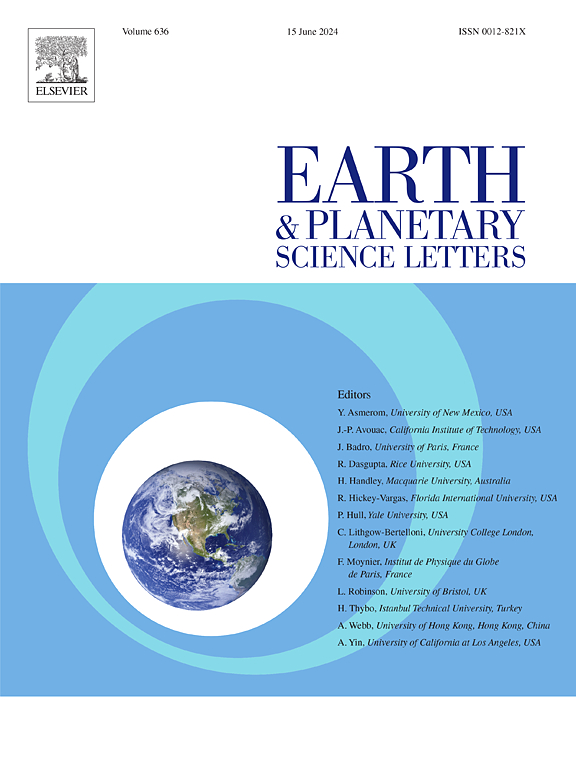Depth-dependent azimuthal seismic anisotropy governed by Couette/Poiseuille flow partitioning in the asthenosphere
IF 4.8
1区 地球科学
Q1 GEOCHEMISTRY & GEOPHYSICS
引用次数: 0
Abstract
Azimuthal seismic anisotropy provides crucial knowledge on spatial patterns of past and present upper mantle deformation. Origins of this deformation were traditionally tied to relative shear between surface plates and mantle, and in turn a constant orientation of anisotropy azimuths with depth. However, observations of azimuthal seismic anisotropy based on surface-wave tomography often feature depth-dependent azimuths in the upper mantle. This is consistent with the existence of low-viscosity, thin asthenosphere that facilitates the channelization of both plate-driven Couette flow and pressure-driven Poiseuille flow. If the two flows are not aligned, their combination yields depth rotations of asthenospheric shear, giving rise to depth dependence of azimuthal seismic anisotropy. In this study, we utilize publicly available azimuthal seismic anisotropy together with predictions from a global mantle flow model that incorporates Couette/Poiseuille flow. We find that Poiseuille flow has significant influence on depth rotations of seismically inferred azimuthal anisotropy. Depth rotations are prominent under the Atlantic basin and the Nazca plate, where modeled asthenospheric flow regimes are dominated by Poiseuille flow. Significant Poiseuille flow may exist beneath the Indian basin, but its depth rotations are small, probably because subduction zones to the north align Couette and Poiseuille flows into the same direction. Our results indicate that interpretation of azimuthal seismic anisotropy cannot be simply associated with relative shearing between plates and mantle. Instead, the relative importance of Couette and Poiseuille flows must be considered to account its depth dependence.
软流层中Couette/Poiseuille流分配控制的深度相关方位地震各向异性
方位地震各向异性提供了过去和现在上地幔变形空间格局的重要知识。这种变形的起源传统上与地表板块和地幔之间的相对剪切有关,反过来又与深度的各向异性方位角的恒定方向有关。然而,基于面波层析成像的方位地震各向异性观测通常具有与上地幔深度相关的方位角。这与低粘度薄软流层的存在是一致的,它有利于板驱动的Couette流和压力驱动的Poiseuille流的通道化。如果两个流不对齐,它们的组合产生软流层切变的深度旋转,从而产生方位地震各向异性的深度依赖。在这项研究中,我们利用了公开可用的方位地震各向异性以及包含Couette/Poiseuille流的全球地幔流模型的预测。泊泽维尔流对地震推断的方位各向异性的深度旋转有显著影响。深度旋转在大西洋盆地和纳斯卡板块下非常突出,在那里模拟的软流圈以泊泽维尔流为主。印度盆地下可能存在明显的泊泽维尔流,但其深度旋转较小,可能是因为北部的俯冲带使库埃特流和泊泽维尔流流向同一方向。我们的结果表明,方位地震各向异性的解释不能简单地与板块和地幔之间的相对剪切联系起来。相反,必须考虑库埃特流和泊泽维尔流的相对重要性,以考虑其深度依赖性。
本文章由计算机程序翻译,如有差异,请以英文原文为准。
求助全文
约1分钟内获得全文
求助全文
来源期刊

Earth and Planetary Science Letters
地学-地球化学与地球物理
CiteScore
10.30
自引率
5.70%
发文量
475
审稿时长
2.8 months
期刊介绍:
Earth and Planetary Science Letters (EPSL) is a leading journal for researchers across the entire Earth and planetary sciences community. It publishes concise, exciting, high-impact articles ("Letters") of broad interest. Its focus is on physical and chemical processes, the evolution and general properties of the Earth and planets - from their deep interiors to their atmospheres. EPSL also includes a Frontiers section, featuring invited high-profile synthesis articles by leading experts on timely topics to bring cutting-edge research to the wider community.
 求助内容:
求助内容: 应助结果提醒方式:
应助结果提醒方式:


